For the first time at O week, a student society which focuses on bringing together students that are First in Family to attend university, or are from a low socioeconomic background, was showcased. The “Student Equity Alliance” (SEA). The society aims to start the conversation about the experience of students who fall into this category, to build a community for these students (who can be very isolated by the prestigious nature of University of Sydney), and to encourage the University to be more systemically supportive of their low ses student population.
The society has been started by students Shayma Taweel and Bridget Neave, the previous and current Project Managers for Social Inclusion in History respectively. Mike Mcdonnell and Frances Clarke have been supporting Bridget and Shayma in their endeavour to set up a student community around this social issue through the Social Inclusion Committee.
The society is off with a bang with 40 members in its first week in action!
Staff are also encouraged to become a part of this community, Bridget and Shayma invite you to like the Facebook page and come to events to be announced in future.
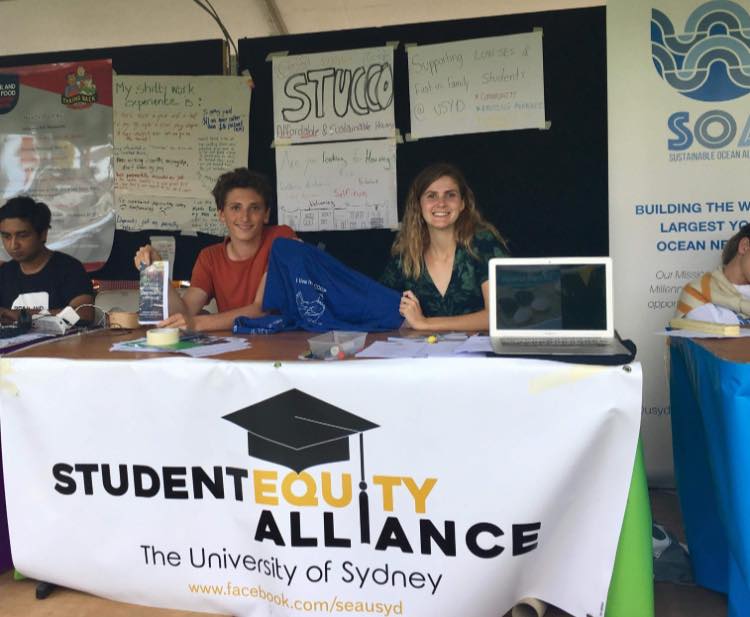
Pictured above are Bridget Neave (SEA President) and Jordan Watkins (representative of the student-managed affordable housing co-op – STUCCO) at O week.
Category: History and Social Inclusion
Cecil Hills High School Mentoring 2018
On Tuesday, February 13, seven volunteers from the University of Sydney ranging from undergraduate to postgraduate student visited Cecil Hills High School to kick off our 2018 History Extension Mentoring Program.
This is the second year we have run the program with Cecil Hills and we were delighted to see that the program had grown from three students to eight this year.
In this session, the students gave our mentors a tour of the school, introduced themselves and their chosen topics, and then worked one on one with the volunteers to refine their questions and think about sources. The topics ranged widely, from representations of Cleopatra and Catherine de Medici in history and film, to communist art in China, to genocide in Serbia. The mentors were impressed by the students’ interests, and knowledge.
The program consists of five school and university visits over a six-month period, where the mentors also provide guidance on applying to and studying at university. We are looking forward to hosting the students here at the University of Sydney in March, when they will meet up with their mentors and get a chance to tour the campus before doing some research in the library.
Social Inclusion awards ceremony at Miller Technology High School (December).
On the 6th of December Frances Clarke, Michael McDonnell and Bridget Neave visited Miller Technology High School on behalf of the University’s Social Inclusion in Humanities Program. Miller Technology is a unique school as 40% of its students are refugees.
The attendees partook in the Stage 6 humanities awards afternoon. The essay winners of the year 11 mentoring program were Wasan Al Zuihari for first prize and Dylan Demerovich for second prize. They had investigated gender roles in Spartan society and Julius Ceaser, respectively. The winners were recognised by the department representatives, their teachers and peers. They were congratulated by Mike and Frances and awarded with bookstore vouchers. The winner for best presentation, Dylan Demerovich, gave his presentation on the life of Julius Caesar to the gathering.
Mike and Bridget followed with short presentations on the value of tertiary education, the challenges that face first in family/low ses students, and how students can find support and opportunities.
The day ended with afternoon tea and the opportunity for the visitors to talk with the students. It was enriching and challenging to learn about the life experiences and future plans of the diverse group of students. Mike, Frances and Bridget all reflected on the infectious enthusiasm and ability displayed by the students in their studies and towards tertiary education.
Unfortunately, Miller Technology has a very low rate of sending students to the University of Sydney. Tony Podolsak, headteacher of history, spoke anecdotally of students giving up places at USYD due to not knowing anyone who had gone there and a perceived lack of support they would have. Barriers like this are what the Social Inclusion unit seek to challenge with the Year 11 Mentoring Program.
A big thanks to our partners at Miller Tech, especially Tony Podolsak, who make the Social Inclusion visits so meaningful to both the students and staff involved.
For anyone interested in being more involved with social inclusion in history and becoming part of the committee for 2018, don’t hesitate to email the project manager Bridget Neave at [email protected].

By Bridget Neave
Year 11 Mentoring Program Presentation Day (August)
To celebrate the culmination of the 2017 Year 11 mentoring program, approximately 40 students and teachers from Granville Boys and Miller Tech joined with History department staff and students at the University. The students gave presentations on the interest-based projects they had been working on with their mentors throughout the year. Students, teachers and mentors alike were impressed by the breadth of projects – from Australian Republican debates to Spartan social class distinctions.
The presentations marked the end of the social inclusion program for 2017 which has been in operation since May. The purpose of this program is to pair high school students with university mentors to assist with their independent project for Year 11 history. The process starts with picking a topic and framing a question, moves into gathering sources and conducting research, then to structuring the essay. Finally, the writing the essay occurs as well as the transformation of the essay into a final presentation.
The program also provides the chance for the Year 11 students to become more familiar with the University of Sydney and creates a space where the students can ask mentors questions about their university experiences. Unofficial connections between the university, and students from a diversity of backgrounds and areas, is what the social inclusion program seeks to create and enhance. Mentors of the program report coming away from the presentations uplifted, and with a sense that they are helping to steer Sydney University’s educational outcomes in a meaningful direction. The connections between the student, the mentor, and a love of history were described as beneficial for all involved.
Frances Clarke, Social Inclusion coordinator, commented on the project:
“Listening to the history presentations is fun as well as enlightening. It actually feels a bit festive. The students seem excited to be here, telling us about the projects that they’ve been working on for so long. The Usyd student mentors are in the audience to see the culmination of all their mentoring work. And the teachers look proud to see their students at a podium, giving a mini lecture in front of an audience of strangers (something that I couldn’t have imagined doing in high school). I always learn something from the students’ papers but, more than that, I find their courage inspiring. It’s a reminder that history can be empowering in more ways than one—not just through uncovering unique pasts or contextualizing the present, but also simply through the act of sharing compelling material. The first time that I attended a presentation day, I decided it was one of the best things I’d ever been to on campus, and this year’s presentations only confirmed that conclusion.”

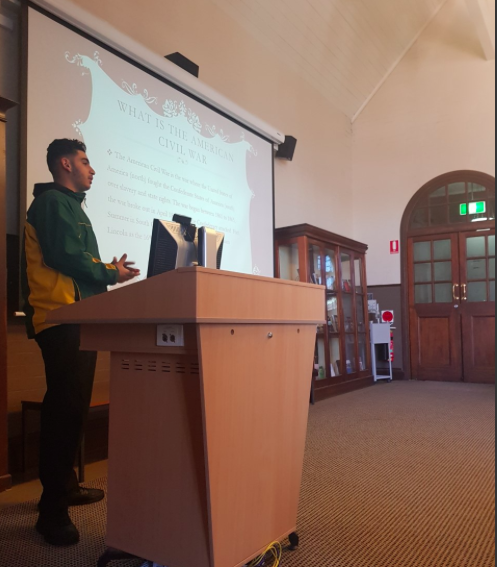
Social Inclusion in History looks forward to continuing and building on work like this, in the 2018 Program!
By Bridget Neave & Emma Kluge from the Social Inclusion Unit
Chifley College Prize Ceremony
NB: This blog entry comes courtesy of the students and staff at Chifley College Senior Campus, Mount Druitt. Many thanks especially to Dianne Harper.
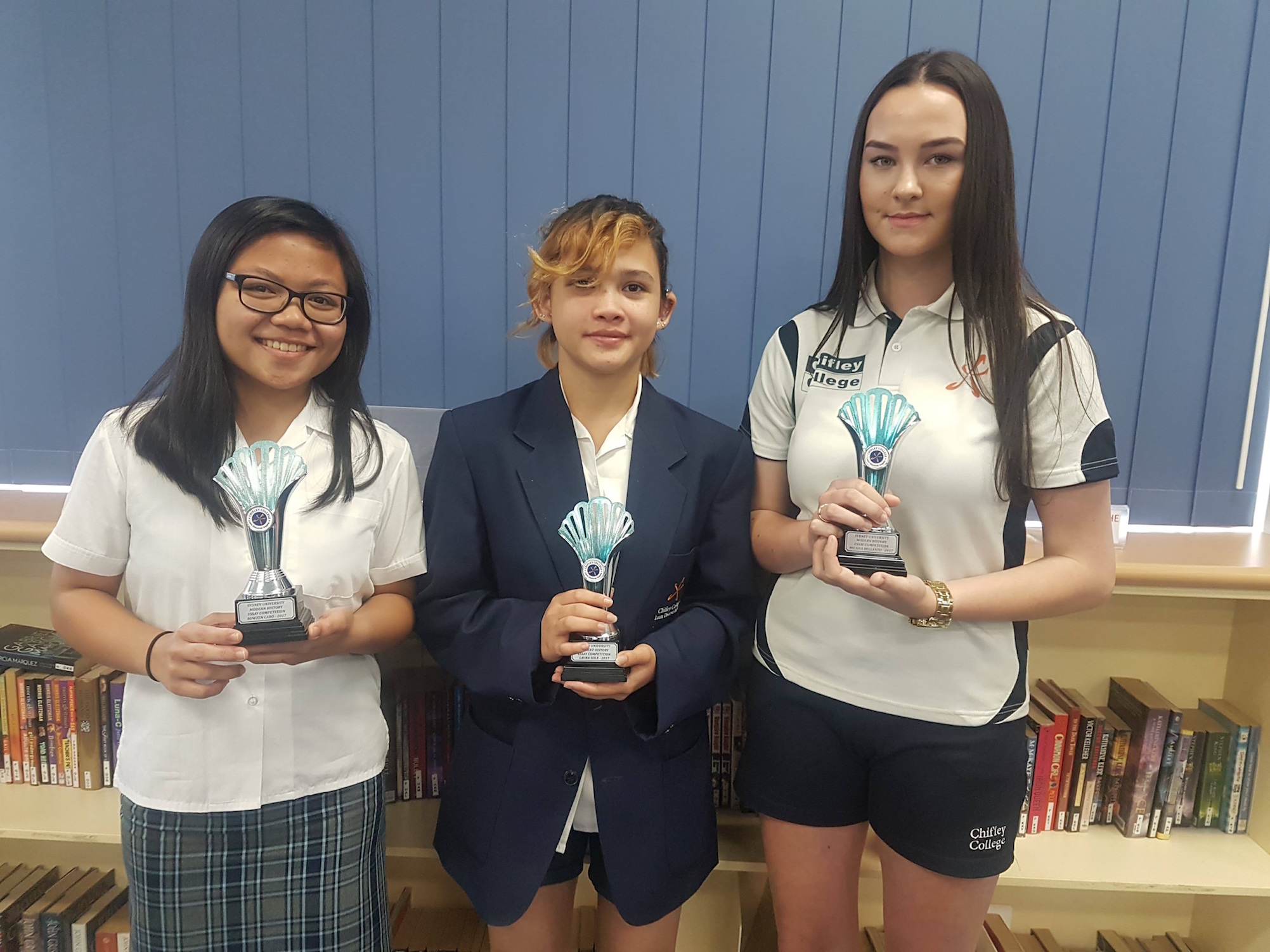
Prize-winners Laura Sole, Rowzen Caro, and Micaila Bellanto
The development of cults in Roman Egypt was influenced by both Egyptian and Greek traditions, and the abolition of the slave trade played out very differently in England and America. Participants in the Cult of Isis were promised the secrets of life and death and the transatlantic slave trade had both long term economic and social effects.
These are some of the interesting facts that Chifley College Senior Campus students explored while researching their Ancient and Modern History Historical Investigations.
Rowzen Caro and Micaila Bellanto were named the joint winners of the 2017 Sydney University Modern History Essay Competition, one of the school’s top prizes for Year Eleven History Students.
Micaila, a prolific reader and writer about Modern History issues was praised for writing an essay on the transatlantic slave trade that “was well-written and well-presented, and demonstrates both sound knowledge of the content, and a sophisticated University-level approach to the topic. Micaila’s explanation of the shift in the status of Africans in colonial America due to changing demands for labour demonstrated a sophisticated historical analysis.”
Laura Sole, the winner of the 2017 Sydney University Ancient History Essay Competition, explored the variety of religious practices in 4th century Egypt. The judges thought the examples chosen to do this showed Laura was “thinking like an historian” and was “well-researched and argued, the essay showed good attention to the historiographical debate and had a really strong conclusion.“
The essay competition is held in conjunction with the Department of History at Sydney University, and judged by academics from both the modern and ancient disciplines. Sydney University and Chifley College Senior Campus have been working together since 2014 as part of an equity program in order to encourage students to achieve academic excellence and to consider University as an option.
In 2017, six students have been awarded conditional scholarships under the Sydney University E12 program. As well as the essay competition, the partnership includes a mentoring program with History Extension students as well as regular visits of senior students to the university campus.
Rowzen, who placed first in the competition, spent some time talking to current students at Sydney University, chatting about school and university life. She believes that the chance to work alongside university students, and have them support her in her studies, provides an opportunity “to get a feel for what University will be like. It’s really useful, it makes me think about what I will do after my HSC, and helpful in setting goals for academic success.” The judges said that her essay was “written with flair, with a good critical evaluation of a range of sources, and makes a convincing argument.”
Micaila, Laura and Rowzen were presented with their awards on November 10th, by Dr Frances Clarke and Associate Professor Michael McDonnell from Sydney University, in front of many proud parents, carers, teachers, and fellow students. The awards are presented to those students who have explored an area of history to a high academic standard, using sources, exploring historiographical issues and drawing sophisticated conclusions.
Click here for more information about the Department of History’s outreach and social inclusion program
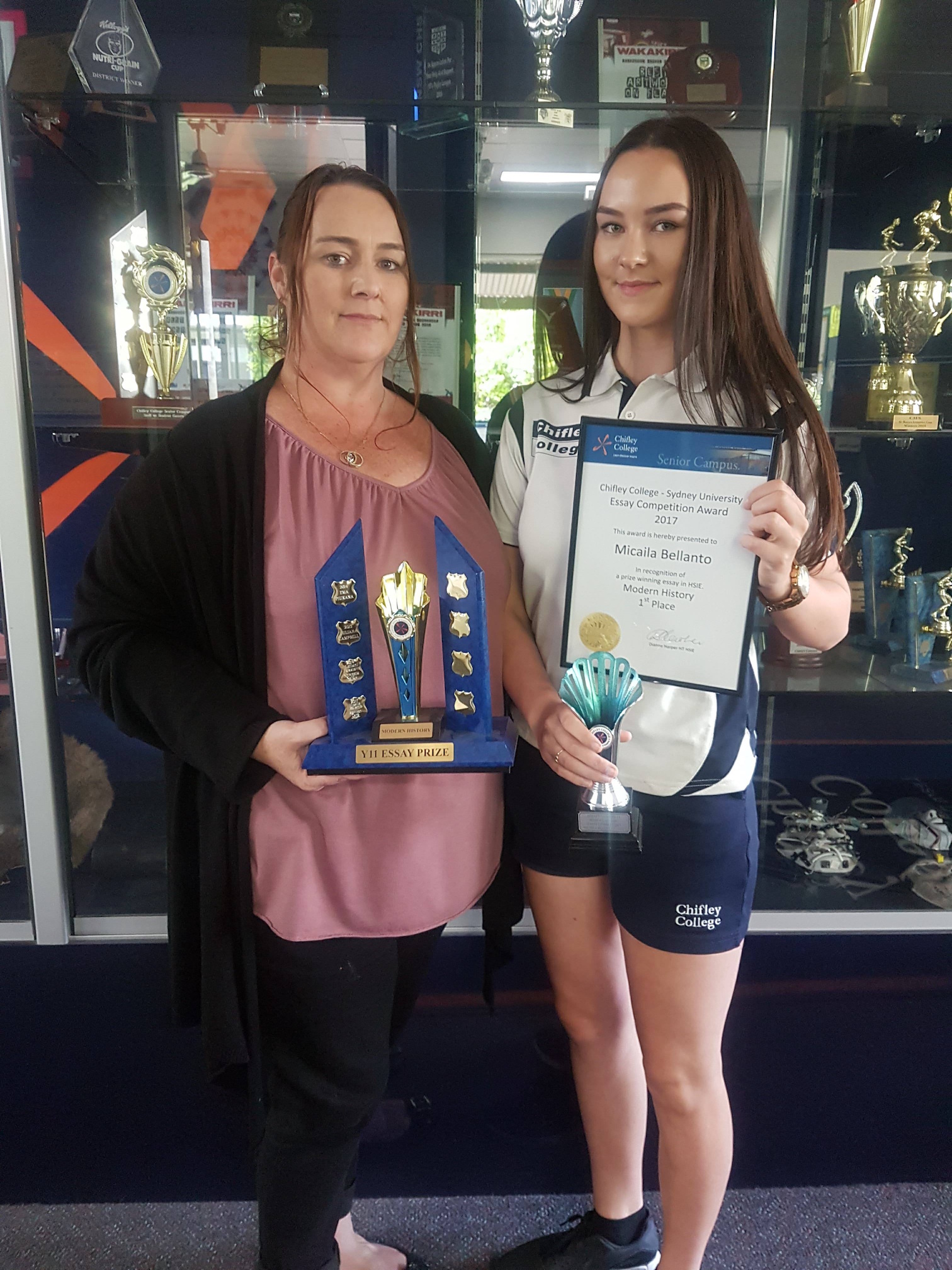
Prize-winner Micaila Bellanto with her mum, Jodie Bellanto
What is the Social Inclusion Program?
The History and CAHS Social Inclusion Program works to address the underrepresentation of students from low socio-economic and diverse backgrounds at the University of Sydney.
The History and Classics Ancient History Social Inclusion Program works to address the underrepresentation of students from low socio-economic and diverse backgrounds at the University of Sydney and in History courses especially. The Program not only initiates and strengthens connections between partner schools and the University, the Program is structured in such a way as to be of service to our partner schools, responding to the needs of both students and their teachers. By familiarising high school students from Mount Druitt, Parramatta, Granville, Campbelltown, Auburn, Liverpool, Coonabarabran, and Broken Hill with the University, the Program aims to foster the aspirations of students from these communities to pursue and excel in tertiary studies. Here is a summary of what we’ve been up to:
First in the Family (FiF)
Created in late 2015 after the schools outreach program prompted new efforts to support students at the University who shared backgrounds with the communities in which we were engaging, we are now spear-heading a Faculty wide effort to create a First-in-Family network among students and staff.
The network meets at least once a semester to invite student membership, with a view of becoming a university-wise, student-run society through the University of Sydney Union. The meetings, as well as promotion online and through student publications Honi Soit and the Student Representative Council (SRC)’s Counter Course Guide, have helped increase the visibility of the network as well as the unique experiences and perspectives of first generation students. In 2017, FiF partnered with a new SRC initiative, the Comprehensive High School Network, to connect first in family students to leadership opportunities in the university community. Run by SRC Education Officers, the Comprehensive High School Network is building a mentoring program where first year students of low SES, first in family or public school backgrounds receive support and guidance from senior students of similar backgrounds. We are currently working on a combined event for FiF and E12 scholarship recipients to help foster a community of support on campus for students from marginalised backgrounds.
School visits to the university
Piloted in 2011, the visits are usually structured around a short learning module consisting of 1-2 sessions. Sessions may involve mini-lectures from university staff and visits to university museum collections. Current postgraduate, honours and/or undergraduate students provide campus tours.
Previous examples include the Medieval Sydney history project (2013) with Granville Boys, Kograh High School and Malek Fahd Islamic School, and the Migrant Sydney history project (2014) with Chifley College. We have just wrapped up this year’s Museum Project Based Learning with Year 7 students from Granville Boys High School where students created virtual museums, presenting what they had learned about curatorial practices to their peers, teachers and parents. Students who give the best presentations receive prizes from the Department of History.
Year 11 Historical Investigation Program
The Department of History has operated the Year 11 Mentoring Program since 2012.
Taking place over 5 sessions, postgraduate research students visit low SES partner schools to mentor students in creating historical projects, with the students visiting the University to learn research and library skills and to present their projects before an audience of their peers, Faculty and students. Students who give the best presentations receive prizes from the Department of History.
This year’s program is currently underway; we have once again partnered with Modern History students at Granville Boys and Ancient History students at Miller Technology High School.
Year 12 History Extension Mentoring Program
Started with 2015 HSC students at Chifley College, this program is similar to the Year 11 Program: university students guide HSC Extension students in the research and writing of their History Projects
For the 2016/17 HSC year, we are working with Chifley College as per previous years. We have also partnered with a new school to the Social Inclusion Program, Cecil Hills High School. Students submit the best essays receive prizes from the Department of History.
Essay prizes to Department of History students
Initiated in 2016, History students are nominated by staff for the best essay on the topic of social inclusion.
Regional Program
Between 2013-2015, the program engaged with the following schools: Willyama High School, Broken Hill High School, Wilcannia Central School, Dubbo Senior College, Gilgandra High School, Coonabarabran High School. The Department of History and CAHS are working on reconnecting with regional schools for late 2017/2018.
We have seen increased enrolments from at least three of our priority partner schools who rarely sent students to Arts and Social Sciences at the University of Sydney in the past. For example, two of the students with whom we worked intensively at Chifley College in Mount Druitt, which has a higher than normal Aboriginal student population, applied for and received E12 scholarships last year. This year, five students applied for the E12 program and have received offers, though not all are enrolling in an Arts degree.
But it is the community engagement aspect of the programs that has driven our efforts most, and regardless of the number of enrolments this engagement might engender, the programs have enriched the experiences of staff, students, and those in the schools while breaking down perceived barriers between an elite University and the communities that it is supposed to serve.
To find out more about the Social Inclusion Program or to get involved in one of its projects, contact Professor Michael A. McDonnell at [email protected]
Miller Technology Prize Ceremony
In August this year, Year 11 students from Miller Technology and Granville Boys High School presented the results of their History Investigative Projects to their peers, mentors, and teachers. On Wednesday, 30 November, Miller Technology held a prize ceremony to acknowledge the best essays and presentations submitted by Miller students for their projects.
The school welcomed back former Miller student and USYD graduate, Annie Ha, to talk about her university experience after successfully completing a Bachelor of Education and Bachelor of Science and landing a full-time teaching role at a nearby school. Annie also gave advice on applying for scholarships and encouraged the students to pursue their interests at university. Mike McDonnell followed Annie’s speech with a talk about the plethora of options available at university, and the many places that studying the humanities especially can take lead.
Mike and History teacher Tony Podolsak awarded prizes for the most outstanding Year 11 Ancient History essays. In first place was Lan Pham, who the judges found, ‘made a clear and compelling case for the the value of comparative history’ in her essay on the sun gods of Ancient Egyptian and Aztec civilisations.
Melissa Clement and Tanya Nguyen came in equal second place, with well-written and researched essays on Constantine’s role in Christianity, and the importance of Taoism, Buddhism, and Confucianism in Chinese history, respectively.
The best presentations from August were also recognised during the prize ceremony: Gabriella Puruto won first prize for her extremely well-delivered presentation on Classical Greek architecture, with Marcelo Locardi-Rauth coming in a close second place. Marcelo’s presentation was on the topic of Pompeii.
To give an indication of the calibre of these presentations, Gabriella presented her work to the assembled students and teachers, as well as the principal, Ken Edge. As had been clear during her August presentation, Gabriella demonstrated that she knew her topic extremely well and displayed an enviable level of comfort with public speaking.
It was a fantastic note on which to end the year, and we wish the students all the best with their HSC studies in 2017.
Chifley College Prize Ceremony
Each year, Chifley College acknowledges its outstanding Human Society and Its Environment (HSIE) students in a prize ceremony. On Friday, 4 November, prizes were awarded to the best-performing Year 11 students in subjects such as Modern and Ancient History, Society and Culture, Aboriginal Studies, and Business Studies.
A select number of Modern and Ancient History students were also recognised for essays completed for their History Investigation Projects. These essays were judged by academics from the Department of History and the Department of Classics and Ancient History.
Jackson Clarke and Leilani Fakatava were joint winners of the Ancient History essay prize, and Kelsi Ryan placed third. Jackson, Leilani and Kelsi had tackled the topic of Roman Emperor Commodus, and the judges were ‘very impressed by the standard of all three papers.’ Each student offered a careful reading of ancient sources and engaged with the complexities of the narrative tradition about Commodus.
For Modern History, Leilani Fakatava and Shweeta Naidu were announced joint winners, with Jackson Clarke coming in third place. The judges found that Leilani’s work on indigeneity expressed ‘a range of sophisticated ideas about the multiple effects of dispossession – encompassing pride, pain, and resilience – and the complexities of racial identification.’ Shweeta’s essay on the Tiananmen Square massacre demonstrated ‘a great facility for historical storytelling, with a narrative that is clear, informative, and wide-ranging.’
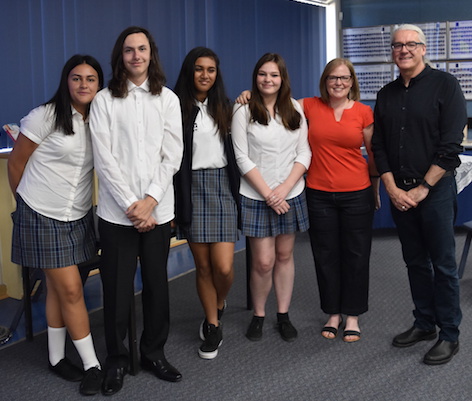
Prize winners Leilani, Jackson, Shweeta, and Kelsi with Dr Frances Clarke and Associate Professor Michael McDonnell
It was a wonderful occasion to celebrate the students’ achievements in the company of their parents, teachers, and peers – especially now that they have commenced their HSC studies.
Awards for the best HSC History Extension and Society and Culture major works were also announced on the day, with Juliana Campbell taking both titles. Juliana participated in the 2016 History Extension mentoring program.
We are excited to work with Chifley students Amber Leigh-Sanders, Jackson Clarke, Kelsi Ryan, Leilani Fakatava, and Shweeta Naidu as part of the 2017 History Extension mentoring program. Leilani is also participating in the University’s Year 12 Bunga Barrabugu Summer Program in the arts and social sciences stream, along with IT & Design student Justin Deville.
This year’s Extension mentors are USYD graduates Amelia Williams, Luke Cantrill, and Mirela Kadric, and they will work alongside Chifley history teacher Terri Katsikaros to guide the students’ research and writing skills over the next six months.
Cecil Hills – History Extension mentoring program
On Wednesday, December 7, the Department of History and the Department of Classics and Ancient History commenced a new partnership with Cecil Hills High School, as part of the History Extension mentoring program. Located in south-west Sydney, Cecil Hills is a large but vibrant school where over eighty percent of students have a language background other than English. In the week prior to our visit, the school had just celebrated its twentieth year.
USYD History students Stephanie Schenk, Sarah Charak, and Samantha Lawford were selected as mentors for the program, and they spent the first session with Year 12 students Alyssa Marsili, Kayla Oshana, and Christina Hanna working to refine their research topics and each develop a specific line of inquiry engaging with historiographical debates. Alyssa, Kayla, and Christina are tackling a range of topics from Native American to Russian and Assyrian history.
The students found this first session very useful. Alyssa wrote that “I was able to gain a different perspective on my chosen topic due to the the feedback I received, which helped me finally attempt to narrow down my argument and thesis.”
Christina thought that “the uni visit was a beneficial experience that raised many questions which I had not thought about concerning my extension project. I left the mentoring session with new ideas and new things to implement into my project. My mentor was extremely helpful and gave me many starting points and suggestions.”
And Kayla added, importantly, “It was an incredibly helpful and fun experience!”
The program consists of five school and university visits over a six-month period, where the mentors also provide guidance on applying to and studying at university. We are looking forward to hosting the students here at the University of Sydney in February, when they will meet up with the students and mentors from the History Extension program at Chifley College Senior Campus and get a chance to tour the campus before doing some research in the library.
Students and mentors work together on initial ideas while teacher Felicity Wicks looks on
We are very pleased to have created this new relationship with Cecil Hills High School, and look forward to getting to know the students better. We are especially keen to encourage students with second languages (and more) to study history at Sydney because those abilities are invaluable in our increasingly globalising world, and of course new international history initiatives.
We are also grateful to teachers Stephanie Haskett and Felicity Wicks for their enthusiasm for the program. Both are creative and inspiring teachers who are already teaching us new tricks for the classroom. Felicity promises to introduce us to the world of Virtual Reality and History on our next visit. While running the mentoring program, we also hope to visit with and host Stephanie’s Year 12 Ancient History students, too.
Finally, in a nice turn, one of the student mentors who volunteered to work with the Cecil Hills group, Steph Schenk (who is in her 3rd year of Uni) told us that she first decided she wanted to go to Sydney Uni when she came here five years ago with Trinity Catholic College, Auburn, and did a campus tour with student volunteers and heard mini-lectures from Helen Dunstan and Robert McCowan. It turned out that was one of the first school visits we organised to the Uni as part of this program, and it was the first time Steph had visited a University. We are very pleased that Steph is now a valuable volunteer on the program, and pursuing a teaching career.
Granville Boys High School Presentations and Awards
Earlier in the year, we reported on the Year 7 Granville Boys High School visit to the University and Museums. We’ve pasted a copy of that report below, and we’ve also provided a link to a short video of that trip created and provided by one of their teachers, Fiona Donnelly: https://youtu.be/vaYaBBJxSXg
Last week, we were invited to GBHS to view the final projects and award prizes and certificates to the best teams and students involved in them.
We were amazed at the work the boys did. They were split in to teams of three and four and tasked with a project of building virtual museum on the topic of “How Do the Dead Speak to Us?” The boys chose who would be their primary researcher, who would undertake the website design, and who would choose artifacts, texts, and pictures to use in their virtual museums.
The boys worked hard but also enjoyed the new challenge of working in a team and building something tangible that their parents and friends could also see. Some of their reflections can be found here on this video created and provided by Ms. Donnelly: https://youtu.be/-oEKbFl8Z5M
Using the website development tool Weebly, the boys created some terrific websites on different archaeological figures including Tutankhamun, Tollund Man, Narrabeen Man, Mungo Man, Otzi the Iceman and Ramesses II.
The work they did is also testimony to the innovative and creative thinking of the HSIE team at Granville, including teachers Fiona Donnelly, Stephanie Ghassibe, Tarek El-Homsi, and Chris Mandarakas.
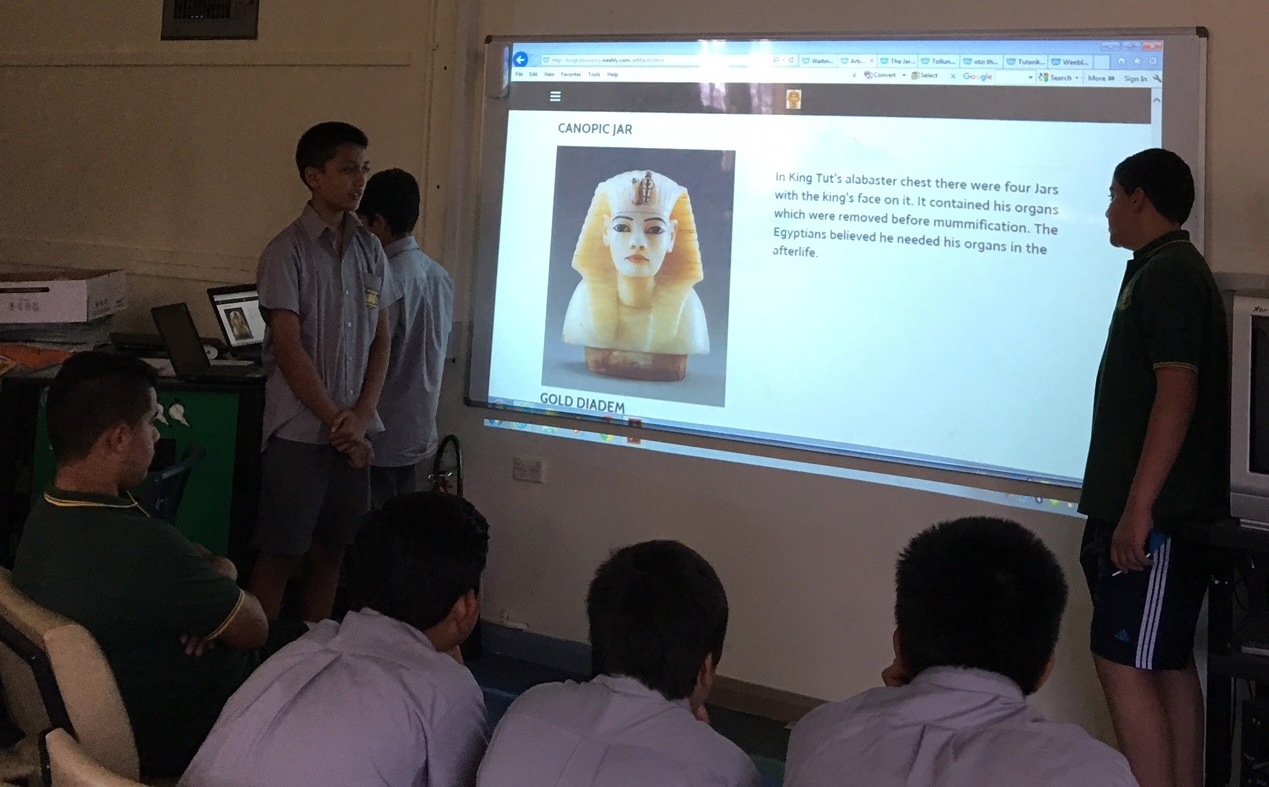
Though all the final presentations were excellent, the Department of History awarded the following certificates and prizes:
Certificate of Excellence and Prize
Hosam Al-Ubudi
Certificate of Excellence and Prize
Noah Kheir
Mohamed Saddieh
Rabih El Kheir
Certificate of Merit
Mohamed Agha
Mortatha Alhessany
Mohamed Dunia
Certificate of Merit
Ben Harfis
Ahmed Al Fararjeh
Zimraan Anjum
We look forward to working with the next group of Year 7 students early in the new year.
Original Report on Visit
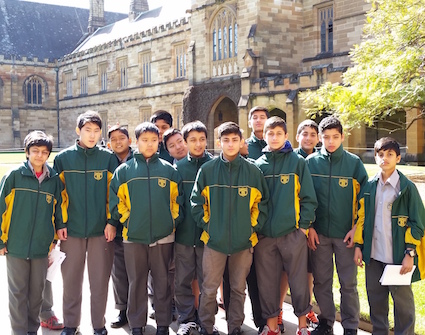
Year 7 Granville students at the University
Over the past four years, several groups of students from Granville Boys High School have visited the University of Sydney as part of the Social Inclusion program – usually Year 11 students completing individual research projects. On the 12th and 17th of August, the university hosted four classes of Year 7s in a pilot for a Project Based Learning program.
For this new project, Granville students will be investigating ancient artefacts and human remains, particularly looking at how remnants of the past are used to bring history to life in the present-day. Their case studies will include Ancient Egyptian mummies, Otzi the Iceman, and closer to home, Mungo Lady and Mungo Man. The students visited the Nicholson and Macleay museums to get a closer look and a better understanding of the importance of artefacts and remains, as well as the processes of preservation, storage, and presentation.
At the Nicholson Museum, the students handled artefacts such as canopic jars, ceramic sherds, mummy wrappings, grave-robber lamps, and Sumerian tablets. While handling these collections, they applied a series of questions to determine each object’s material, date, and place of origin. In the end it was the two swords – one Cypriot, the other Mycenaean – that drew the most attention from the students.
The staff at the Nicholson Museum were terrific guides and hosts for the boys. Craig Barker also took a group for an impromptu chat about the mummies, but quickly found out that at least one of the boys had been doing a little work on his own, and could describe the process of mummification down to the finest detail. His friends, along with us, were amazed.

Dr Craig Barker with students in the Nicholson Museum
After learning about the material cultures of ancient civilisations at the Nicholson, the students explored Macleay Museum’s natural history collection. Upon their arrival, Jude Philp, Senior Curator at Macleay, tasked the students with locating the oldest and weirdest objects on display. Several of the students were also determined to find fake objects – but turns out the entire collection is real! Even at the end of what was quite a long day, the students were bursting with questions about the scientific instruments and animal life on display, how they were collected, and what it is like working in a museum.
We are looking forward to seeing their projects at school. And judging by their enthusiasm for learning about the history of the University and how we study history at the University and Museums, we are also looking forward to having them as students in a few years’ time.
